Hey all, so despite the absolutely brutal heat this summer (we had a record-breaking
31 straight days above 110, smashing the previous record of 18 days), I persisted in an experiment to see how various potted jaboticaba (some of them barely 8-12 months old) would handle the summer heat. Please note that I am not an expert (those of you who ARE experts already know that), I'm relatively new to growing plinia and that I probably could have done even better if I had been able to focus entirely on these guys and not have to spread time over the other plants.
All plants were initially acclimated in May-June (100+ temps) in full shade and, if showing no signs of stress, were migrated to 30%-50% dappled shade. All plants were on drip irrigation of twice-daily 15-20 minutes drip (this was a little high but I was trying to be on the safer side), with our crappy crappy hard city water. Feeding was more inconsistent than I would have liked; I used to a combination of various fertilizers but mostly either Tony's Magic Mix or 420 Rejuvenate along with worm casings plus the occasional worm compost tea from the local worm farm. They received two foilar feeds over four months. I also tried out a local product from the worm farm made of diluted fermented soldier fly larvae, which sounds gross but gave a massive benefit to some other plants in terms of heat tolerance (was game-changing for getting things established this year). Almost everything was in a 50/50 peat/pearlite mix.
TLDR: They got some food, they got copious daily crappy salty water.
Anyway, on to the Jabo pictures taken today. The stuff that did better:
Otto Anderson: 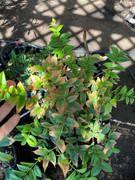
These handled the heat better than almost any other variety except for the INTA (and maybe the AxP, needs more testing). They pushed slow new growth through the heat, didn't defoliate, and despite the usual salt burn on old leaves didn't show a huge reaction to the tap water.
INTA:
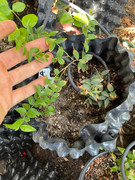
My surviving seedling from five seeds I got from Marcos and holy crap did this one ever love the heat. It had really struggled inside (in the picture, that nub of growth off to the right was 8 months of pre-summer growth) but as soon as it was outside it took off like a rocket and kept growing through the major heat. I'm going to have to keep an eye on this one when it gets cold to see if it's hardy to all seasons or just tropical.
Sabaras: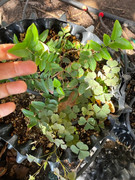
The sabaras just kind of plugged along and then started doing well after it cooled off to the mid-100s. They put on some decent growth in the less-hot periods, didn't defoliate or burn much, they were troopers. Interestingly, they did better with our water when it was stupid hot than they did indoors in the cool for some reason (something that was also true for the INTA).
Frankie's Dwarf (sabara/red-descendant probably from Frankie's nursery in Oahu): 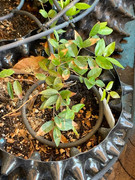
I got these from Shiloh last year and, despite being somewhat slow growing inside, they managed to outpace some of the reds in the heat on account of not defoliating. These guys are little tanks.
AxP (white/red cross from Hawaii):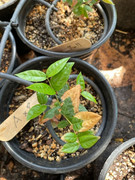
These initially went dormant in the heat (no new growth but didn't lose any foilage either) but have since pushed new growth once the temps wound down below consistent 110s. I think these may be good candidates for heat like the the otto andersons and sabaras/frankies but we'll see. They certainly are doing better than the white jaboticaba.
Red Hybrids:
Almost every small red hybrid did the same thing when exposed to the high temps: initially pushed new growth, then dropped most or all of their leaves, then slowly and painfully recovered and pushed more growth over the next month or two. They've all mostly recovered but some of them look ratty as hell. The larger, older red hybrids took it better; I know from experience that the bigger ones (1-2+ feet tall) do okay out here in the heat in shade but this was my first time trying a bunch of them at once.
Taiwan varieties (T11, T13):
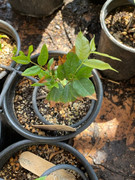
These have been slow growers inside and out, but are actually doing better outside with less signs of salt stress on the new growth. I think these have the potential to do well here given that they were so young and yet had no leaf loss/ major stress.
Honey Drip: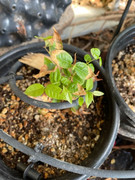
I only had one of these, but the one that I had, did well. Took the heat okay, put on some growth in the cooler days, didn't defoliate.
Stuff that did not so well:Whites: 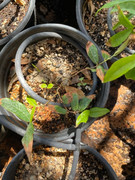
Whites took the heat fine BUT they hate our salty water something fierce so basically showed neither growth nor defoliation and just kind of sat there looking sad all summer, except for one that died from what I think was salt accumulation and not the heat specifically. I think if I had a better water source for these they would do just fine in the heat. Whitex crosses seem to do better (see AxP, Taiwanese varieties). Also, they may still adapt.
Campo Ramon: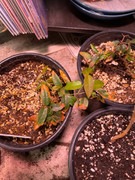
I only had one that I moved outside, so it may not be a good test, but the Campo Ramon didn't last long in the 110+ before I had to move it back inside (defoliated and did not push new growth, etc.) However as soon as it was back inside it flushed new growth, so I may try again when it is larger and has a bigger rootball.
Grimals: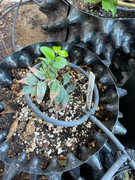
Grimals all threw a fit when moved into the heat. I'm not actually sure if this was the heat or just what grimals do in response to LITERALLY ANY CHANGE in their environment, but almost all of them lost some number of leaves and put on no or minimal growth, and one died. However, instead of moving them back inside like my single campo ramon, I moved them into full shade on the north side of the house surrounded by potted hibiscus (coolest place in the yard) and they survived and started flushing new growth once it cooled down.
Red Lantern: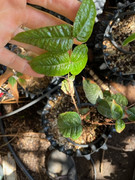
This was inconclusive since I only had one of these and it was the only thing I didn't personally start from seed (I got this one from Bellamy's a while back); it hasn't been super happy inside but started to perk up outside in the 90-104 range but struggled past 110 or so. I moved it back inside through the worst of the summer and have since put it back outside; we'll see how it does.
Stuff that either up and died or almost did so:Restinga.
This was a bit of a bummer, but almost all of the restinga tested completely defoliated and (unlike the reds) did not recover. I moved two back inside and they are slowly putting out a few leaves of new growth on the main stem but may still be goners. If they survive they might just be houseplants again, we'll see.
Conclusions: Vigor matters but not as much as ancestry; the reds were far and away more vigorous (and recovered from initial defoliation relatively rapidly in most cases) but some varieties were clearly more heat-resistant from the get-go. If I were trying to grow a less-crazy amount of these trees I would probably focus on the otto andersons, sabara derivatives and reds; I'd also try and get them up to a foot or so before moving them into the 105+ hellhole. Suprisingly (and happily) almost every variety except for the white jaboticaba got used to the salty garbage hose water when they absolutely had to to survive. They're still showing some signs of salt burn depending on the variety but also still pushing new growth.
Also, what kills and damages these guys is usually not the high day temps as long as they have some shade, but the unrelenting night temperatures above 95+. They can take high day temps if the nights allow them to recover. The day temps have continued to be 105+ on and off for weeks, but the night temperatures cooled back down a tiny amount, and everything started pushing more growth again. Also I think they would have done better if the pots were on grass instead of patio/pool deck due to less reflected heat but I had what space I had.
For my next dumb trick, I'm going to try to grow and fruit some in the ground under a moringa canopy. I'll also be testing yellows, vexators, peruviana and a couple of others I started over the last six months. I may try out some simple hydroponic setups next year as well.
Also, if anyone is interested in another write-up, I can do a follow-up about survival for other eugenias/plinias/myrciara (Rainforest plum did well in part shade, cambuca did okay, mulchi did not enjoy the heat at all, etc.)






















